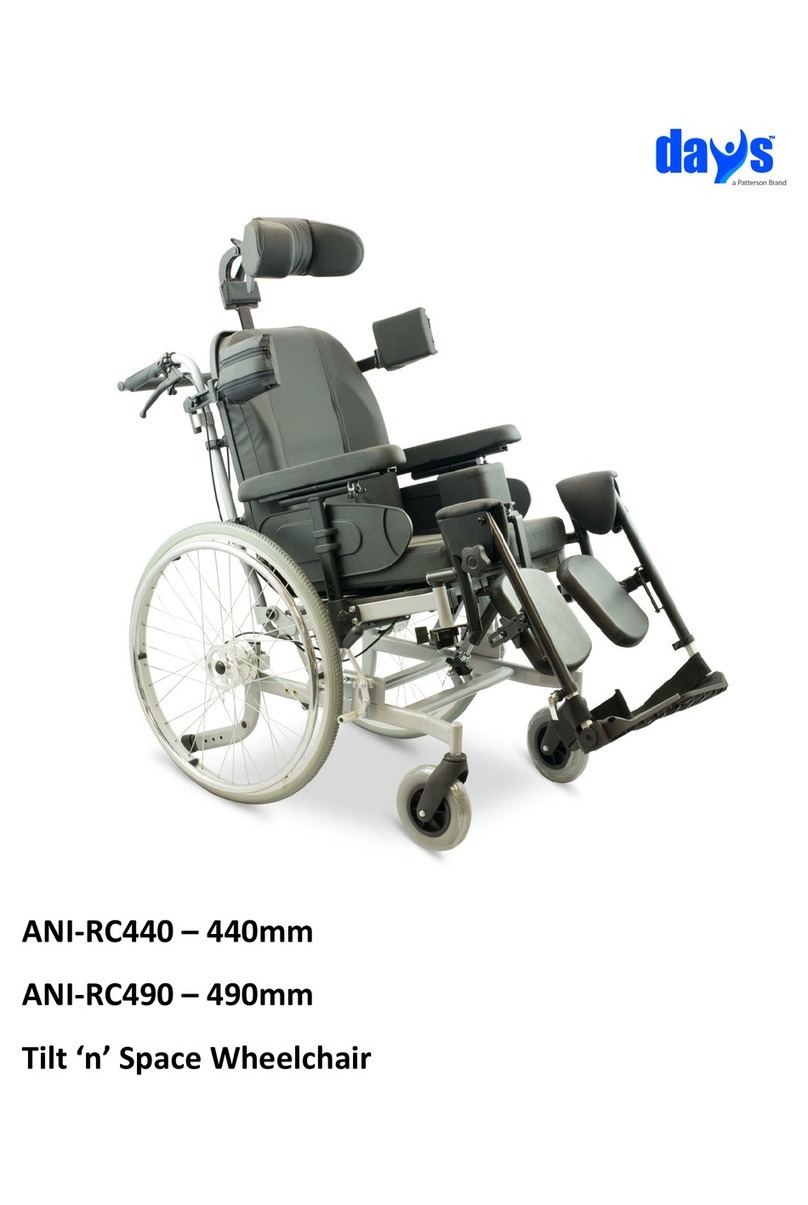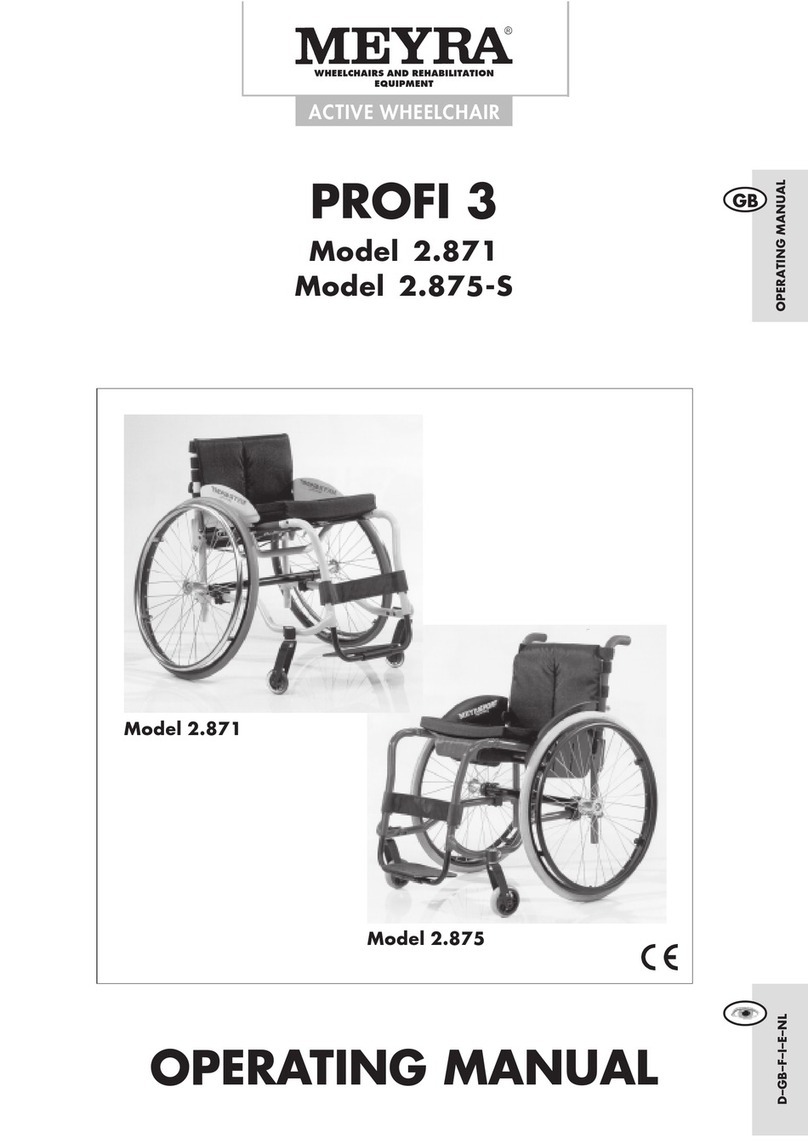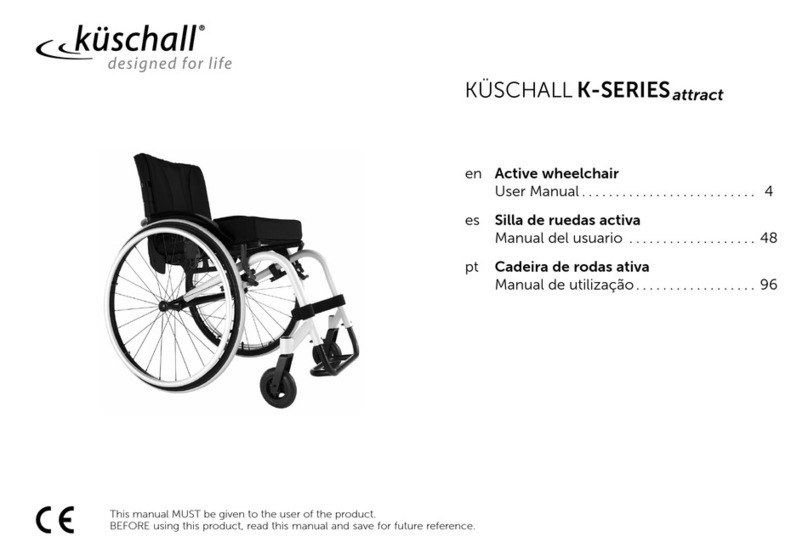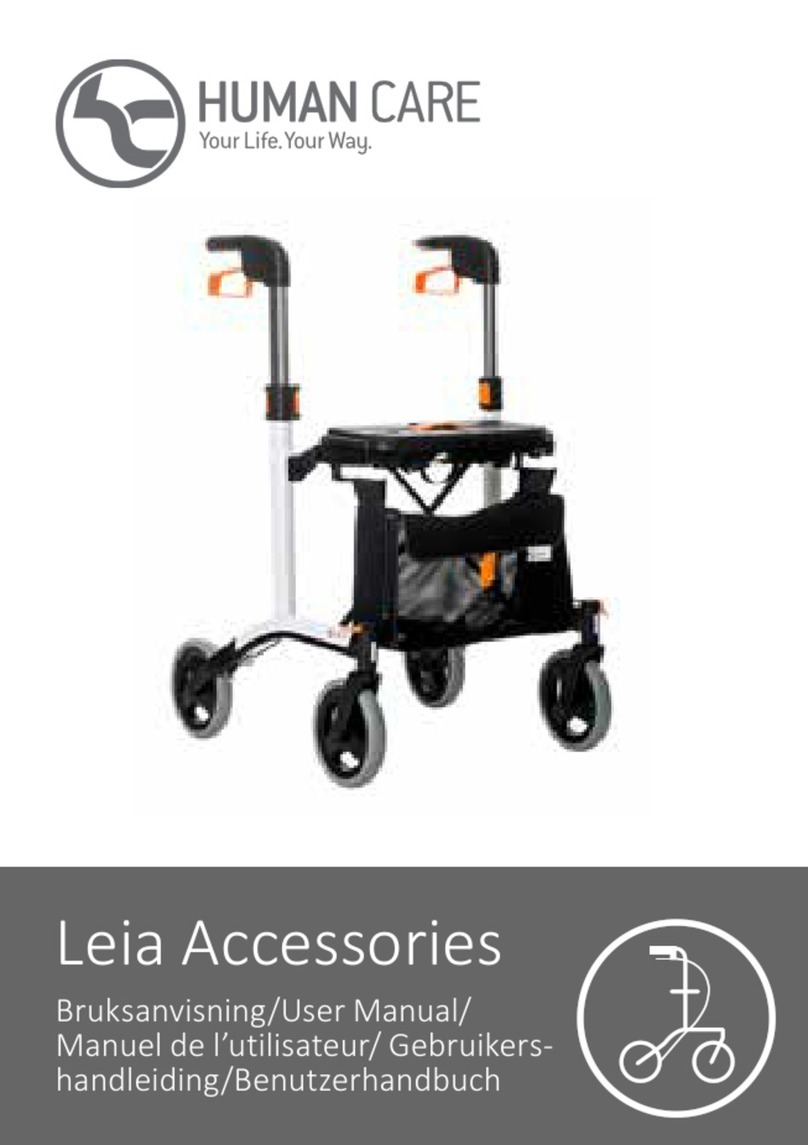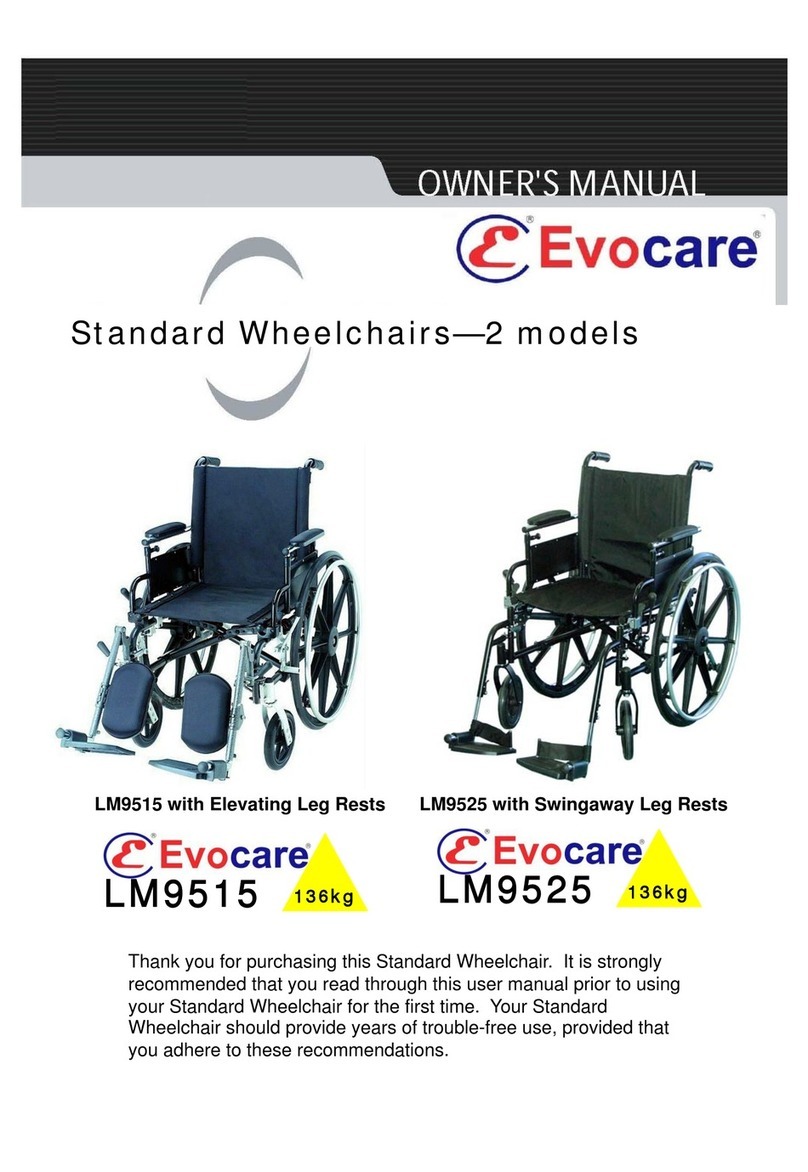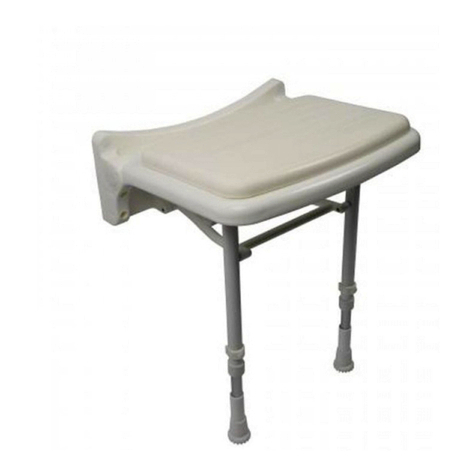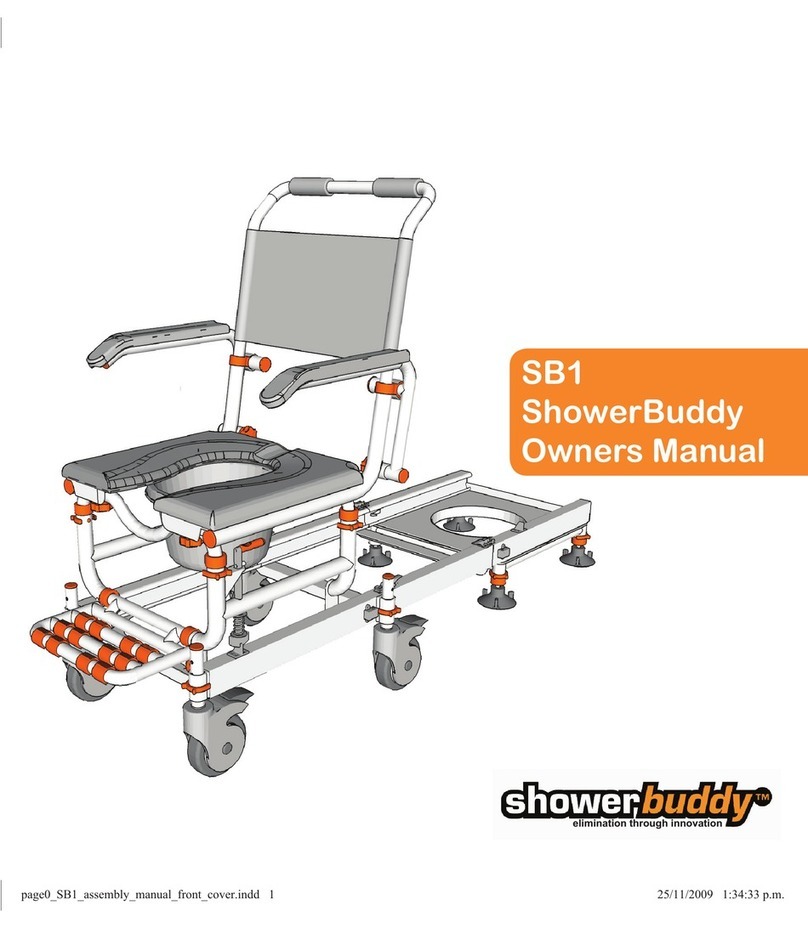Days HP-3DX Escape User manual

Days Healthcare Escape Power Chair
User Manual
Days Healthcare Escape Powerchairs are warranted for 24 months from the date of
purchase on side frames and crossbars.
(NB Batteries are warranted for 12 months.)
•
During the warranty period any parts that have become defective due to faulty
workmanship or material will be repaired or replaced without charge by Days
Healthcare supplier/dealer
•
The warranty excludes tyres, punctures and items that become worn due to normal
wear and tear such as upholstery and armrest pads
•
The warranty excludes all items that have been subject to undue wear and tear and
misuse
•
Unauthorised changes or modifications will forfeit your warranty
•
If a defect or fault is discovered, the Days Healthcare supplier/dealer from whom the
Wheelchair was purchased should be notified immediately
The warranty does not extend to the consequential costs resulting from fault clearance,
in particular freight and travel costs, loss of earnings, expenses, etc.
The manufacturer will not accept responsibility for any damage or injury caused by
misuse or non-observance of the instructions set out in this user manual.
Days Healthcare Ltd • North Rd • Bridgend Industrial Estate • Bridgend • CF31 3TP
Tel: +44 (0) 1656 664700 • Fax: +44 (0) 1656 664750 • Email: info@dayshealthcare.com
www.dayshealthcare.com
Days Healthcare Ltd reserves the right to change the specifications without prior notice.
Dealer Stamp
D/N: P1-057-06
HP-3DX
Escape
Mid-Wheel Drive Powerchair
Escape
USER MANUAL

Days Healthcare Escape Power Chair
User Manual
- 25-

Days Healthcare Escape Power Chair
User Manual
INSTRUCTIONS FOR DISPOSAL
TO COMPLY WITH NATIONAL LAW, THE FOLLOWING
INSTRUCTIONS ARE GUIDELINES FOR THE DISPOSAL OF YOUR
PRODUCT AT THE END OF ITS LIFE OR WHEN IT CEASES TO
FUNCTION ECONOMICALLY.
RECENT LEGISLATION ON ELECTRICAL EQUIPMENT INDICATES
THAT THE EQUIPMENT MUST BE DISPOSED OF IN A PROPER
MANNER.
•
THE PRODUCT AND /OR ITS COMPONENTS ARE NOT TO EN-
TER THE SYSTEM OF LANDFILL SITES.
•
THE PRODUCT AND/OR ITS COMPONENTS ARE NOT TO BE DIS-
POSED OF IN DOMESTIC HOUSEHOLD WASTE.
•
THE ELECTRICAL AND MATERIAL PARTS ARE TO BE DISPOSED
OF AS SCRAP OR RECYCLING MATERIALS.
•
LOCAL WASTE COLLECTION DEPOTS ARE AVAILABLE TO
ADVISE AND DISPOSE OF ELECTRICAL PRODUCTS.
•
BATTERIES WHICH CONTAIN LIQUID ACID MUST BE STORED
AND DISPOSED OF SEPERATELY AT THESE DEPOTS.
•
PLEASE ENQUIRE ABOUT DISPOSAL DEPOTS WITH YOUR
LOCAL AUTHORITY.
•
SHOULD YOU REQUIRE FURTHER ADVICE, PLEASE CONTACT
YOUR SUPPLIER OR NEAREST DEALER.
- 24 -
! " #
$% # &! ! #
' # $(( )
( ) * )
(+ , '- + )
. ( , $ )
/ 0 1 2 / 0 ,
'/ 0 2 $ 2
/ / 0 2 * * 3
/ 0 3 * 3
* 4 * 3
5 4 * 64
* 4 (7 6
*8/ 0 4 6
+ ( $! 66
*8 $ ( 6
%9:: * '% 6
; 6
- 3 -

Days Healthcare Escape Power Chair
User Manual
Welcome to the Days Healthcare Escape Powerchair and thank you for choosing
our product. This latest model has been designed with specific practical user
needs in mind. It combines solid, rugged construction and high-tech electronics,
safety and performance. We are confident that it will prove a reliable companion
in your home as well as outdoors.
This manual contains some useful tips and information on safety, operation and
maintenance. Please read it carefully to ensure that you get maximum enjoyment
and benefit from your new independence and mobility.
Whenever you require special advice and attention do not hesitate to contact your
local Days Healthcare dealer. He has all the equipment and know-how to provide
an expert service and assistance on technical and clinical applications to suit your
particular need.
The Escape Powerchairs are intended to assist and improve mobility for those
individuals who are less able or have walking difficulties who wish to maintain
their independence and freedom.
Your day to day activities will depend on your physical capabilities and your own
specific circumstances. If in doubt seek medical advice first.
The information is this booklet provides a general guide on how to use your chair
safely and correctly. Do not use the chair without reading this manual first.
As a Powerchair user you must be aware of the risks involved to both yourself
and others. We recommend that you take out ‘Third Party Liability’ insurance to
cover you against any possible claims. Advice and policies are available from
general insurance companies or alternatively ask Days Healthcare dealer/supplier
for details.
Although by law you are not required to hold a driving licence you are responsi-
ble and fully liable for proper operation and use of your Powerchair. You must
ensure that your chair is maintained and is in a good condition at all times.
- 4 -
Classification Type ‘B’ Indoor/Outdoor
Overall Length 106 cm (42”)
Overall Width 63 cm (25”)
Overall Height (Folded) 83 cm (33”)
Overall Weight 95 kg (208 lb)
Weight Heaviest Part: 45 kg (99 lb)
Wheel Size (Front) 20 cm (8”)
Wheel Size (Mid Drive-Wheel) 31 cm (12”)
Wheel Size (Rear castor) 12.5 cm (5”)
Electrical System 24 V
Brakes Electronic, Regenerative; Magnetic
Battery 40 A/h Deep-Cycle 12V × 2
Battery Charger 240 V - 24 V 4 Amp
Obstacle Ability 4 cm (1½”)
Maximum User Weight 130 kg (286 lb)
Maximum Speed 4 mph (6.5 km/h)
Ground Clearance 8 cm (3”)
Turning Radius 67 cm (26½”)
Maximum Safe Slope 12°(1:5)
Maximum Climbing Angle 12°(1:5)
Range 20 miles (32 Km) -
Varies with passenger weight,
temperature, battery type and condition, ground surface, etc.
Seat Width 50 cm (20”)
Seat Depth 48 cm (19”)
Seat Height 47.5 to 52.5 cm (18½ to 21”)
Backrest Height 49 cm (19½”)
Footrest Length 35 to 45 cm (14 to 17½”)
TECHNICAL SPECIFICATIONS
- 23 -

Days Healthcare Escape Power Chair
User Manual
The following information is intended to assist in the location of a fault that may
occur in a certain part of your Powerchair’s electronics. Go to the number in the
list which matches the number of flashing bars and follow the instructions.
If the problem persists after you made the checks described below contact your
dealer. Do not use the Powerchair and turn-off the power.
1 Bar The battery needs charging or there is a bad connection to the battery.
Check the connections to the battery. If the connections are good, try
charging the battery
2 Bar The left hand motor has a bad connection. Check the connections to the
left hand motor
3 Bar The left hand motor has a short circuit to a battery connection. Contact
your service agent
4 Bar The right hand motor has a bad connection. Check the connections to the
right hand module
5 Bar The right hand motor has a short circuit to a battery connection. Contact
your dealer
6 Bar The Powerchair is being prevented form driving by an external signal.
The exact cause will depend on the type of Powerchair you have, one
possibility is the battery charger is connected
7 Bar A joystick fault is indicated. Make sure that the joystick is in the center
position before switching on the control system
8 Bar A control system fault is indicated. Make sure that all connections are
secure
9 Bar The parking brakes have a bad connection. Check the parking brake and
motor connections. Make sure the control system connections are secure.
10 Bar An excessive voltage has been applied to the control system. This is
usually caused by a poor battery connection. Check the battery
connections
- 22 -
The Days Healthcare Escape Powerchair is a type ‘B’ indoor/outdoor vehicle
with a maximum carrying capacity of 130 kg (20 stone) which must never be
exceeded. It has a maximum speed of 4 mph (6.5 km/h) and is classified as an
‘Invalid Carriage’ for use indoors, on pavements, footpaths, pedestrian zones and
areas free from motor traffic. Use on the road or highway is not allowed except
for the purpose of crossing.
- 5 -
Headrest
Backrest
Rear Castors
Mid Drive-Wheel
Front Castors
Footplate
Adjustable Seat
Joystick Control
Armrest

Days Healthcare Escape Power Chair
User Manual
Do not use on the road, except when crossing between pavements. When
crossing the carriageway of a public road always take extra care and observe
the Highway code
Do not turn off the controls by switching the ON/OFF button when moving at
speed. This will bring the brakes on immediately and could cause damage to
the controls
Do not rideoverdeep, soft terrain (soft dirt, loose gravel, deep grass)
Do not attempt to mount a kerb higher than specified
Do not carry passengers
Do not sit in your Powerchair if the unit is in freewheel mode
We recommend that you do not sit on your Powerchair when in a vehicle, but
transfer to a vehicle seat
Always stop before making a sharp change of direction
Always engage a slow speed when going down gradients
Do not use the joystick in an erratic manner when going up or down an incline
Do not drive in reverse down a slope or kerb
Always keep your feet on the footplate when moving
Do not stand on the footplate when getting in or out of the chair
Do not expose the Powerchair to direct rain or high humidity (i.e. in the bath-
room) as it may cause it to malfunction (electrically or mechanically)
We recommend the use of safety belt
Always keep your pneumatic tyres to the correct pressures
Always make sure that the batteries are sufficiently charged before setting out
on a journey
Do not use parts, accessories or adapters other then those authorised by Days
Healthcare Ltd
Keep the Powerchair away from children. It is not intended to be used as a toy
- 6 -
We recommend that your Powerchair is serviced by your local dealer every six
months. It is in your best interests, not only to ensure your personal safety but also
to ensure long life and reliability. Regular service will identify early damage and
worn components avoiding unnecessary faults occurring.
•
Check all connectors are secure properly, properly mated and free from damage
•
Castor bolts are tight and all fasteners are secure
•
Adjustable height arms operate and lock securely
•
The drive wheels mounting bolts are secure and there is no excessive side
movement or binding when spun
•
Tyres do not show excessive wear or damage
•
Castors for proper tension, i.e. spinning castors should come to gradual stop
•
Check joystick gator around the base of the joystick for damage or splitting
•
Motor parking brakes function correctly
•
The chair rolls straight (no excessive drag or pull to one side)
•
Pivot points are free of wear or looseness
•
Seat and backrest upholstery is not for ripped or sagging
•
Frames are not worn or bent
!
Paintwork and plastic mouldings can be cleaned with a damp soft cloth of warm
soapy water. Do not use any harsh abrasive cleaners, bleach base fluids or
solvents.
Seat and back upholstery can be cleaned with a general purpose upholstery cleaner
or sponged with warm soapy water.
- 21 -

Days Healthcare Escape Power Chair
User Manual
CAUTION! -
•
The charger is for indoor use only
•
Do not use an open flame whilst batteries are being charged
•
Do not use the battery charger if it has been dropped or misused as damage to
the electronics could occur
•
Do not leave the charger plugged in the mains supply and switched-off.
Always remove the plug
"
The battery gauge works in the following way:
Located on the control box, the battery gauge has three colour bars:
When you switch on the control system, the battery gauge shows an estimate of
the remaining battery charge.
If the battery shows red, yellow and green, the batteries are charged.
If the battery shows just red and yellow, then you should charge the batteries as
soon as you can.
If the battery gauge shows just red, either steady or flashing slowly, then you
should charge the batteries immediately.
At full charge all ten lights will be on. As the battery charge drops during
Powerchair operation successive bars will extinguish. Except in emergency, do
not drive on discharged batteries. If you ignore the warning (the bottom bars
flashing
)
and the battery charge drops further to a level where there is no longer
sufficient charge to allow safe driving, the controller will automatically cut the
power supply to the motors and the power chair will come to abrupt stop.
- 20 -
#
When using indoors beware of narrow doors, steps, high surfaces, protruding
wall fittings and everyday household items such as children’s toys, electrical
appliances etc. Take extra care in kitchen environments.
To ensure stability and safe control you must maintain proper balance at all
times. The Powerchair is designed to remain stable during normal use as long as
you do not move you centre of gravity outside the normal seating position.
When reaching/bending forward do not lean your body out of the Powerchair further
than the length of the armrests. Do not attempt to reach objects by sliding forwards to
the edge of the seat.
When reaching/bending backwards do not reach any further than your arm will
extend without changing your seating position.
Never attempt to use an escalator or stairway, always use a lift.
Occasionally check that the adjustments of the footrests, armrests and controller
are secure and are set in the most comfortable position for use.
We recommend the use of the safety belt provided with the chair.
Avoid use in rain, to avoid the possibility of water penetration into the
electrically operated equipment.
$
Powerchairs may be susceptible to electromagnetic interference (EMI) which is
energy emitted from sources such as radio stations, TV stations, two-way radio,
and cellular phones.
Avoid coming into close contact to them whilst the Powerchair is turned-on.
Switch off immediately to avoid possible abnormal, erratic movement and control
of your Powerchair.
- 7 -

Days Healthcare Escape Power Chair
User Manual
% & '
% &
To gain access to the adjustment bolts, tilt the seat to the rear and lift the coloured
plastic moulding at the front. Remove the two sets of nuts and screws, slide to
adjust vertical square tube to the required height and refit both screw and nut to
secure.
Using a hexagon key, rotate screw clockwise or anticlockwise to adjust the angle
of the footplate.
% % &
Under the armrests there is a bolt and lock nut that can be
adjusted up or down to change the angle of the armrests.
To determine the same angle for the opposite armrest, count
the exposed threads on the adjustment bolt.
Located under each armrest at the rear is a hexagon key screw. By turning anti-
clockwise to release, the armrest can be adjusted and then reset in position by
re-tightening the screw.
Measuring the distance from the end of the armrest pad to the end of the armrest
support post will allow setting of both armrests at the same length.
Below the rear of the armrest on the down supporting tube there is a hexagon key
screw to allow for adjustment. To adjust the height loosen the screw, adjust arm
to the desired height then re-tighten the hexagon key screw. Repeat the procedure
for the other armrest.
- 8 -
" "!
"
The Powerchair is supplied with two sealed deep cycle, maintenance free
batteries. These are fitted under the seat in the centre of the Powerchair.
These batteries are different from ordinary car batteries and should be charged
with the charger specifically for this type and make of battery.
CAUTION! - Using incorrect battery size and/or voltage may cause damage to
the power chair and have an adverse effect on the performance
specifications.
To ensure long battery life, do not allow the batteries to become totally
discharged. If the Powerchair is not used for a length of time the batteries must
receive a full charge once a month and remain fully charged during storage.
"
The battery charger supplied with your Powerchair is fitted with an automatic
electronic switch that terminates the charge when the batteries are fully charged.
To avoid reducing battery life always fully charge new batteries before initial
use. Please note that the batteries will not perform to their peak until first six to
ten charging cycles have been completed.
The front panel of the battery charger has two lights - red and green. Steady red
light indicates that charger is on from the mains and is ready to charge. Flickering
red light signifies incorrect or bad connection. The other light is yellow/orange
when charging, which turns to green when charging is complete.
To re-charge the batteries, connect one end of the battery charger power cord to
the charging socket and the other end to a 3-pin grounded wall outlet and switch
on at the mains.
Do not switch off or interrupt the charging cycle before charging is complete
(typically from 8 to 12 hours depending on depth of discharge).
When charging is complete always disconnect from the main supply first
followed by unplugging the charger from the chair.
The charger also has its own ON/OFF switch located in the opposite end to the
two-way display lights. Ensure this is switched on to charge your batteries.
- 19 -

Days Healthcare Escape Power Chair
User Manual
We recommend that you do not sit on your Powerchair when in a vehicle, but
transfer to a vehicle seat. A Powerchair secured in a vehicle will not provide the
equivalent safety level and security as the vehicle’s seating systems.
However, when transfer is not practical or impossible, ensure the following:
1) Check that the vehicle is suitably designed, insured and equipped to transport
a passenger seated in a Wheelchair
2) Remove any part of the Wheelchair (accessories, etc.) that can be easily detached
and store it in the vehicle’s luggage hold
3) Make sure the Wheelchair is transported in a forward facing direction. Rearward
facing is only acceptable if the passenger’s head and back can be supported by a
suitable bulkhead
4) Use the buckle seat belt (if fitted) with your chair as additional restraint
- 18 -
Beneath the rear of the seat there are two handknobs: one on
each side. Release the handknob and slide each armrest tube
outward. Re-tighten the handknob securely when in the
required position.
% &
The seat can be adjusted to three height positions by
setting the front and rear adjustment support posts into
the Powerchair chassis to the required height.
To adjust the seat height, remove the seat by
unscrewing the hand knob underneath the front of the
seat and tilt seat to the rear. Pull seat forward and lift-
off from the two rear hinge brackets. Unclip front
securing pin to release seat front adjustment bracket.
Remove coloured plastic cover from chassis.
Remove nut and bolt retaining both seat rear hinge
brackets, adjust to required height and refit bolts and
nuts to secure.
Assemble coloured plastic cover to chassis.
Assemble and adjust seat front adjustment bracket to
required height and fit and clip pin to secure. Re-assemble seat and tighten front
hand knob to secure.
Remove the seat assembly.
Remove the four bolts and washers securing the seat pan and
separate the seat assembly.
Using the three sets of mounting holes in the seat assembly in combination with
the mounting hole in the seat pan, three seat depth positions can be achieved (in
25 mm increments).
Rear seat supports
Front seat support
- 9 -

Days Healthcare Escape Power Chair
User Manual
The backrest is angle adjustable and also folds forward to assist in reduction of
overall height for storage and transportation.
On the left side of its base is a lever, which when pulled upwards allows the
backrest to rotate on its hinge mechanism to the required position.
To raise headrest, lift headrest up to the desired posi-
tion. Headrest is locked in position when an audible
click is heard.
To lower headrest, push release tab towards the in-
side of the chair and lower headrest to desired posi-
tion.
Hold the bayonet end in one hand, and pull on the webbing to increase or
decrease belt length with the other. When length is correct, adjust slide buckle to
suit.
! "(% &
The control box can be adjusted so that it is in a convenient position for use. To
adjust the unit forward and backwards immediate underneath the armrest pad at
the rear there is a hexagon key screw. When turned anti-clockwise to release, the
armrest can be adjusted and then locked into position by re-tightening the screw.
- 10 -
% &
The rear castors are spring-loaded which are adjustable
to suit your everyday need and environment. Between
the two rear castors is mounted the suspension unit
which has a round disk located on top of the spring.
By rotating this disk you can increase or decrease the
tension setting.
Clockwise rotation increases tension.
Anti-clockwise decreases tension.
- 17 -

Days Healthcare Escape Power Chair
User Manual
Circumstances and individual needs will vary from person to person, but if there
are difficulties we advise you to consult your therapeutic adviser who will help to
develop your skill for appropriate transfer method that suit your individual
requirements.
During transfer always make sure that the brakes are in a locked position and the
Powerchair is manoeuvred as close as possible to the transfer seat.
!")
If your chair stops for no apparent reason, it is probably due to the circuit breaker.
The circuit breaker can be located at the rear of the chair. On rare occasions, it
happens that there is a temporary overload on the electric circuit. If this occurs, the
circuit breaker button will pop out. To reset, turn the key to the OFF position, press
circuit breaker button and then turn the key to the ON position.
* #
To push the Powerchair by hand or in the event of a fault
or battery failure the motors/gear boxes can be released
allowing the Powerchair to be pushed.
The levers should be switched to the freewheel position
on the gearbox by rotating them through 90°.
CAUTION! - Always re-engage the freewheeling device
after use. Failure to do so may result in injury
Regularly check the condition of front and rear tyres for wear and tear. Contact
your supplier for replacements. Your Powerchair may have split rim wheels which
are held together by screws or bolts. When these are removed the wheel rim
separates for easy access to carry out puncture repairs or tyre replacements.
If you have pneumatic tyres fitted, the pressure indicated on the side of the tyre
wall should not be exceeded.
Freewheel lever
- 16 -
#
Your Powerchair is fitted with the latest up to date electronic controls. The
control box is normally fitted to the right side of the chair.
Switch on your Powerchair with the ON/OFF Button. When the chair is turned on
the battery level indicator lamp lights up. This also can be used as a fault finding
guide.
The Powerchair is ready for use if the green or orange battery level indicator bars
are illuminated. The range of the chair is relative to the number of bars lit, as they
show how much charge is left in the batteries. A true reading will only be taken
when the Powerchair is stationary. When only the red bars are illuminated, do not
use the Powerchair and charge the batteries.
The joystick controls the speed and direction of the Powerchair. The further the
joystick is moved from its central location the faster the Powerchair will move in
the direction the joystick is pushed. To slow down, guide the joystick towards its
central position.
!!"
For your first drive choose an area with plenty of space to drive your Powerchair
and select the low speed setting until you are familiar with the controls. In a short
time you will be in total control and can then increase the speed.
Move the joystick gently forward. The more you push the joystick forward the
faster you will travel, but you will not exceed the speed limit imposed by the
speed control knob, regardless of the joystick position.
To reverse, pull the joy-stick to the rear, beyond its centre (neutral) position. The
joystick is also your steering lever. Move it to the left and you will turn left.
Move it to the right and you will turn right.
When you want to stop or have to make an emergency brake application, simply
release the joy- stick. It will automatically return to the centre (neutral) position.
At this moment the brakes of the electric motors will cut in and bring the Power-
chair smoothly to a standstill.
Once the Powerchair is at a standstill, it is automatically locked in its parking
position by the electromagnetic safety brake system. If you intend to remain
parked for any length of time, or you are leaving the power chair switch off the
controller to avoid accidentally moving the joystick, which would release the
braking system.
- 11 -

Days Healthcare Escape Power Chair
User Manual
# $
This is a 10 segment display which indicates control unit in ON/OFF
mode and also displays state of charge of the battery.
Additionally, any faults in Powerchair electric system are indicated.
See Troubleshooting Guide for details.
% & '% (($
This button turns the unit on and off
Do not use this button to stop the Powerchair, except in an extreme
emergency
$
This button operates the warning horn
$
This button decreases the chairs speed setting or a lower drive profile
)$
This button increases the chairs speed setting or a higher drive profile
*)
This is a 1 to 5 light display which indicates your speed setting. 1 light
indicates minimum, upto 5 lights indicating maximum
- 12 -
+, *, +
The Powerchair has climbing power that enables you to overcome gradients of up
to 12° (1:5). Always approach an incline directly, not at an angle, and follow it up
or down directly avoiding zigzag movement.
CAUTION! - Never attempt to climb or descend an incline which has a slippery
or icy surface.
While going uphill or downhill there is no need for drastic corrective joystick
movements. The electronic controller ensures that the extra
power required for climbing is automatically applied to the
motors, so that the selected speed is maintained. This is achieved
by the micro-computer of the electronic controller compensating
automatically for any extra power required.
The same applies when you travel downhill. The electromagnetic
safety brake gives you full control over your Powerchair at all
times. This unique brake system enables you to descend at a
constant slow speed.
You can stop at any time while you are climbing or descending.
Simply release the joy-stick as on the flat. The electromagnetic
safety brake will ensure that the Powerchair is positively locked
and secured in parking position until you are ready to continue
your journey.
,!
Due to the mid-wheel drive feature combined with rear castors, your Powerchair
has limited kerb-climbing capabilities. We therefore suggest avoiding kerbs and
steps whenever possible. Maximum height is 40 mm.
To climb kerbs and steps:
Approach the kerb head-on slowly. Shortly before the front wheels make contact
with the kerb push the joystick fully forward for maximum power.
Do not allow the Powerchair to come to a halt midway through manoeuvre. If
possible, use gentle upper body movement to assist motion.
When climbing kerbs you will find that your Powerchair will smoothly overcome
the kerb without the need for drastic speed variations.
CAUTION! -Ensure all wheels have mounted the kerb before changing
direction.
BE CAREFUL
- 15 -

Days Healthcare Escape Power Chair
User Manual
)- )
The VSI control system can be locked to prevent unauthorised use. The locking
method is via a sequence of key presses and joystick movements, as detailed
below: -
)*
1) While the control system is switched on, depress and hold the on/off button
2) After 1 second the control system will bleep. Now release the on/off button
3) Deflect the joystick forwards until the control system bleeps
4) Deflect the joystick in reverse until the control system bleeps
5) Release the joystick, there will be a long bleep
6) The wheelchair is now locked
)*
1) Use the on/off button to switch the control system on. The maximum speed /
profile indicator will be rippling up and down
2) Deflect the joystick forwards until the control system bleeps
3) Deflect the joystick in reverse until the control system bleeps
4) Release the joystick, there will be a long bleep
5) The wheelchair is now unlocked
- 14 -
!
The battery gauge and maximum speed /profile indicator show the status of the
control system.
1. Battery Gauge is Steady
This indicates that all is well.
2. Battery Gauge Flashes Slowly
The control system is functioning correctly, but you should charge the battery
as soon as possible.
3. Battery Gauge Steps Up
The Powerchair batteries are being charged. You will not be able to drive
the Powerchair until the charger is disconnected and you have switched the
control system off and on again.
4. Battery Gauge Blinks Once Every 2.5 Seconds
The control system has “gone to sleep” because the Powerchair has not
been driven for a period of time. To re-start, switch the system off and on
again.
5. Battery Gauge Flashes Rapidly (even with the joystick released)
The control system safety circuits have operated and the control system
has been prevented from moving the Powerchair.
This indicates a problem somewhere in the Powerchair’s electrical system.
Please follow this procedure:
• Switch off the control system.
• Make sure that all connectors on the Powerchair and the control system
are mated securely.
• Check the condition of the battery.
• If you can’t find the problem, try using the Troubleshooting Guide
• Switch on the control system again and try to drive the Powerchair. If the
safety circuits operate again, switch off and do not try to use the Power
chair. Contact your service agent.
- 13 -
Table of contents
Other Days Wheelchair manuals
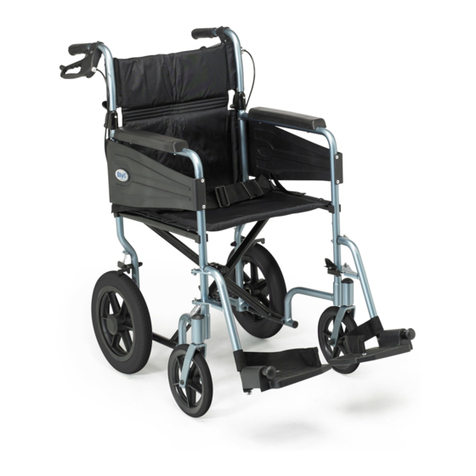
Days
Days Escape Lite User manual
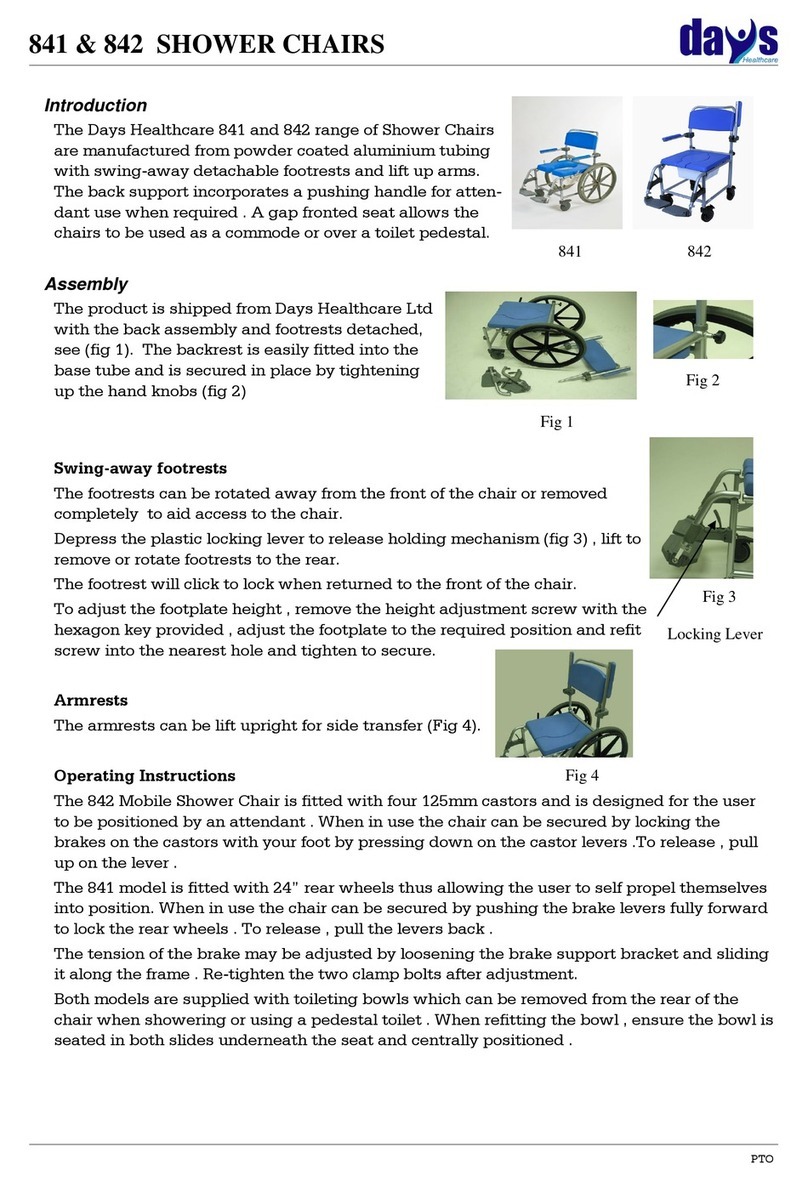
Days
Days 841 User manual
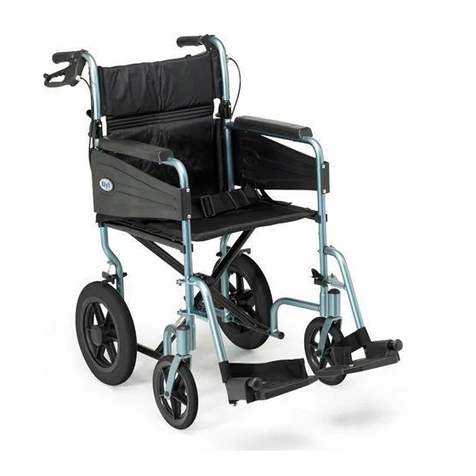
Days
Days 338 Escape LITE User manual
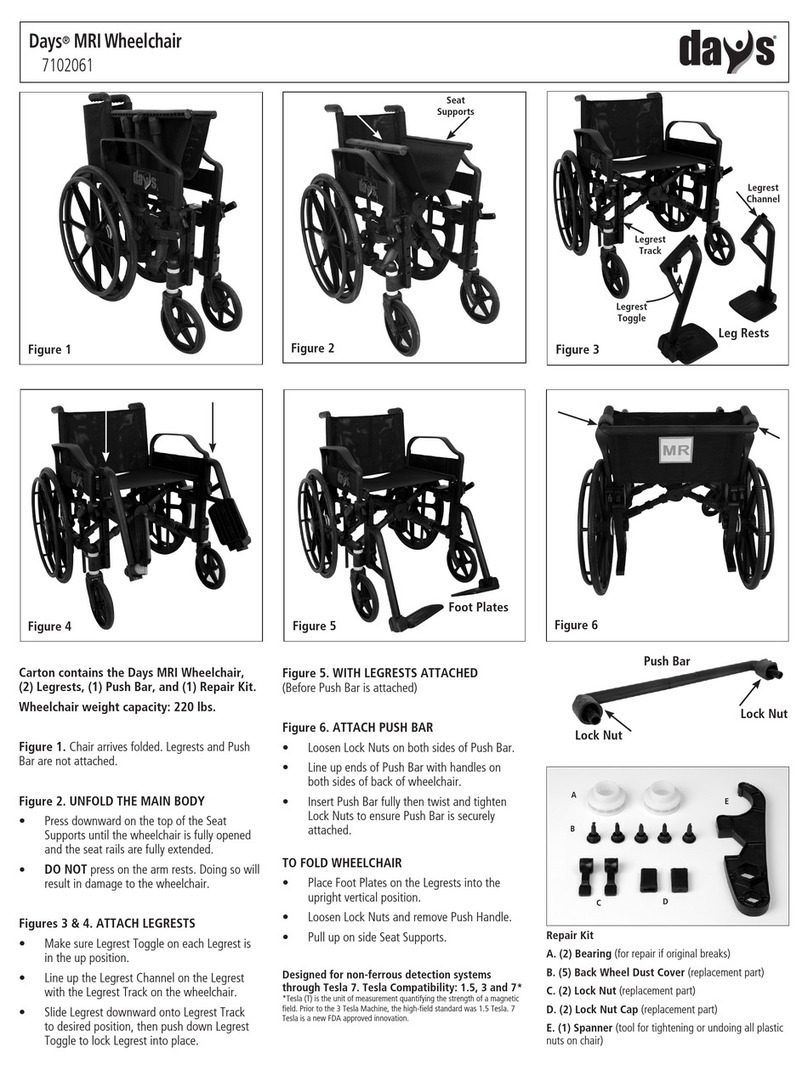
Days
Days 7102061 User manual
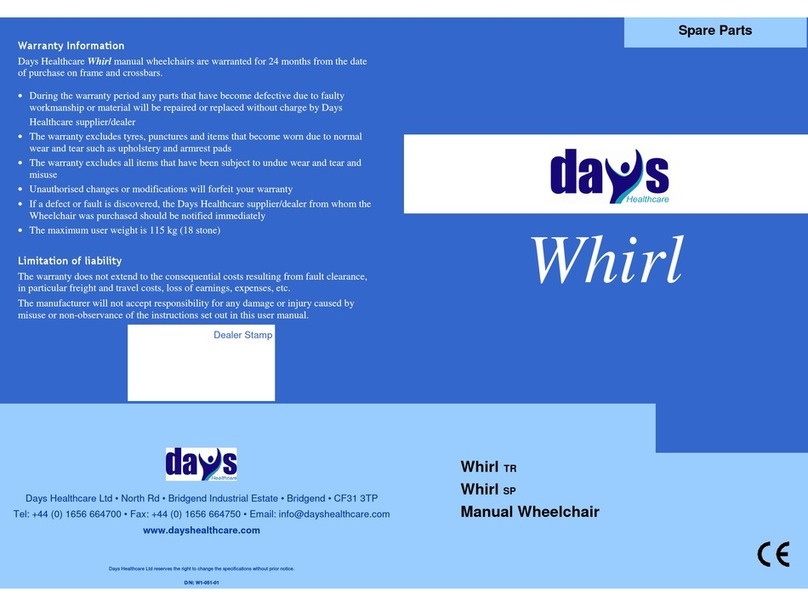
Days
Days Whirl TR User manual

Days
Days 338 Escape LITE User manual
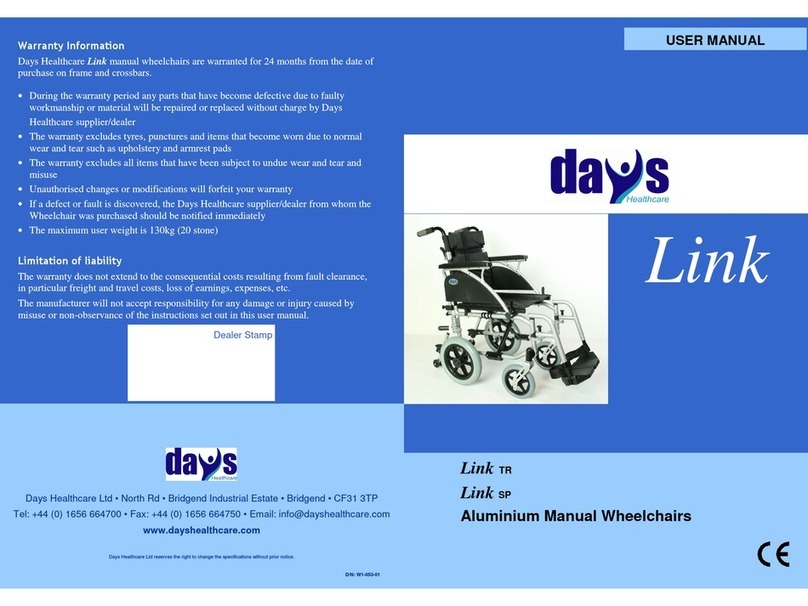
Days
Days Link TR User manual

Days
Days Equinox TR User manual
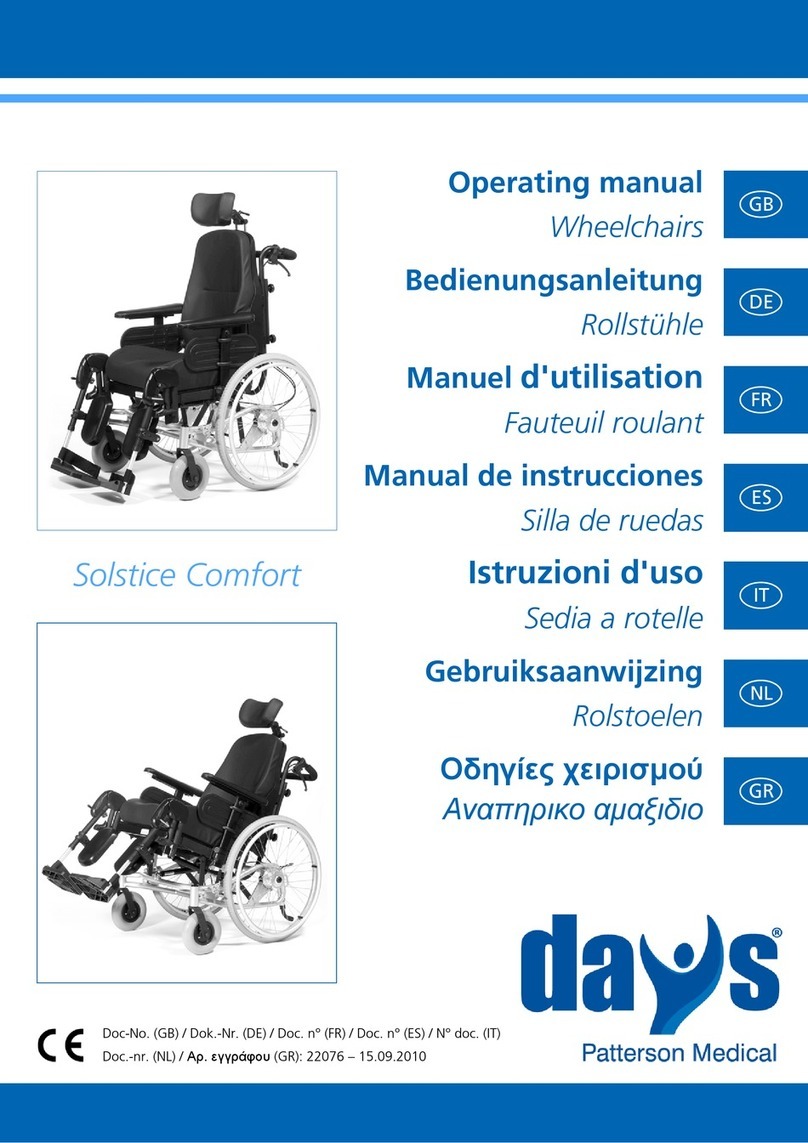
Days
Days Solstice Comfort User manual
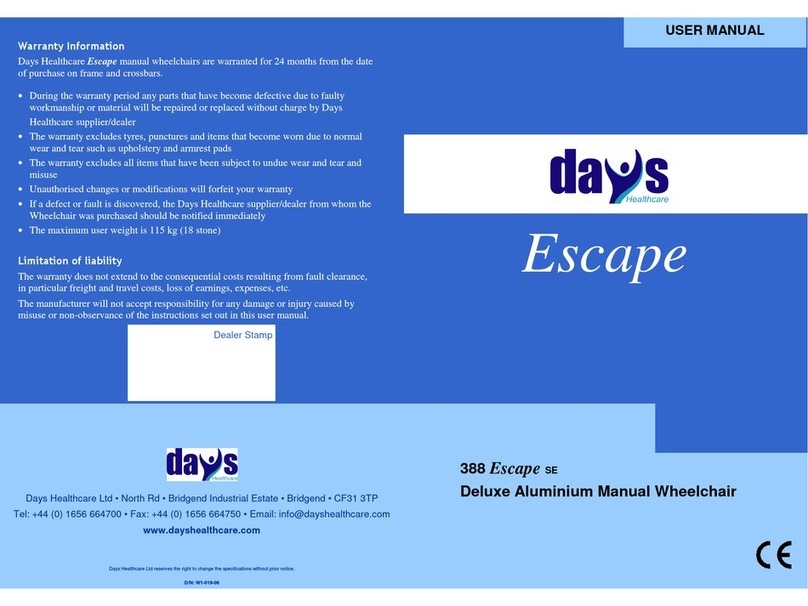
Days
Days 388 Escape SE User manual
Popular Wheelchair manuals by other brands
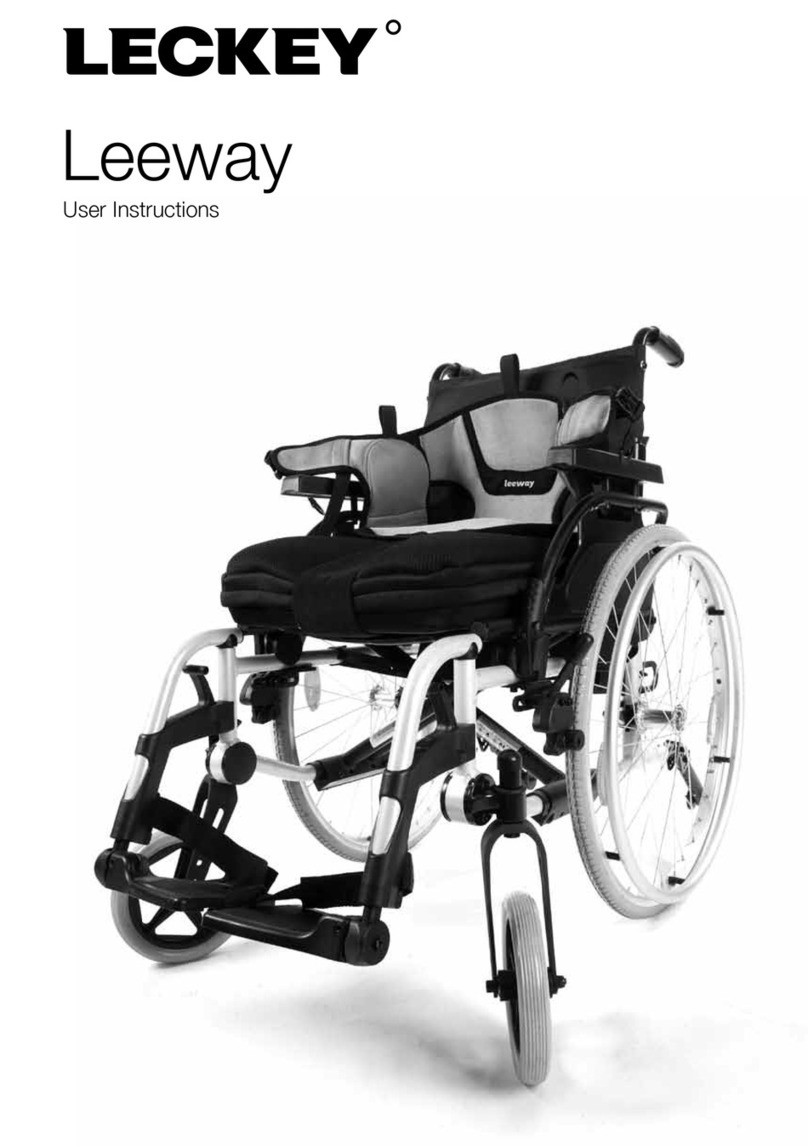
Leckey
Leckey leeway User instructions

Permobil
Permobil C500 owner's manual

Everest & Jennings
Everest & Jennings Traveler L3 Plus 3F012 user manual

Invacare
Invacare Wheelchair Pronto M61 user manual

Invacare
Invacare IVC 9780 Assembly, installation and operating instructions

Mopedia
Mopedia RS846 instruction manual


